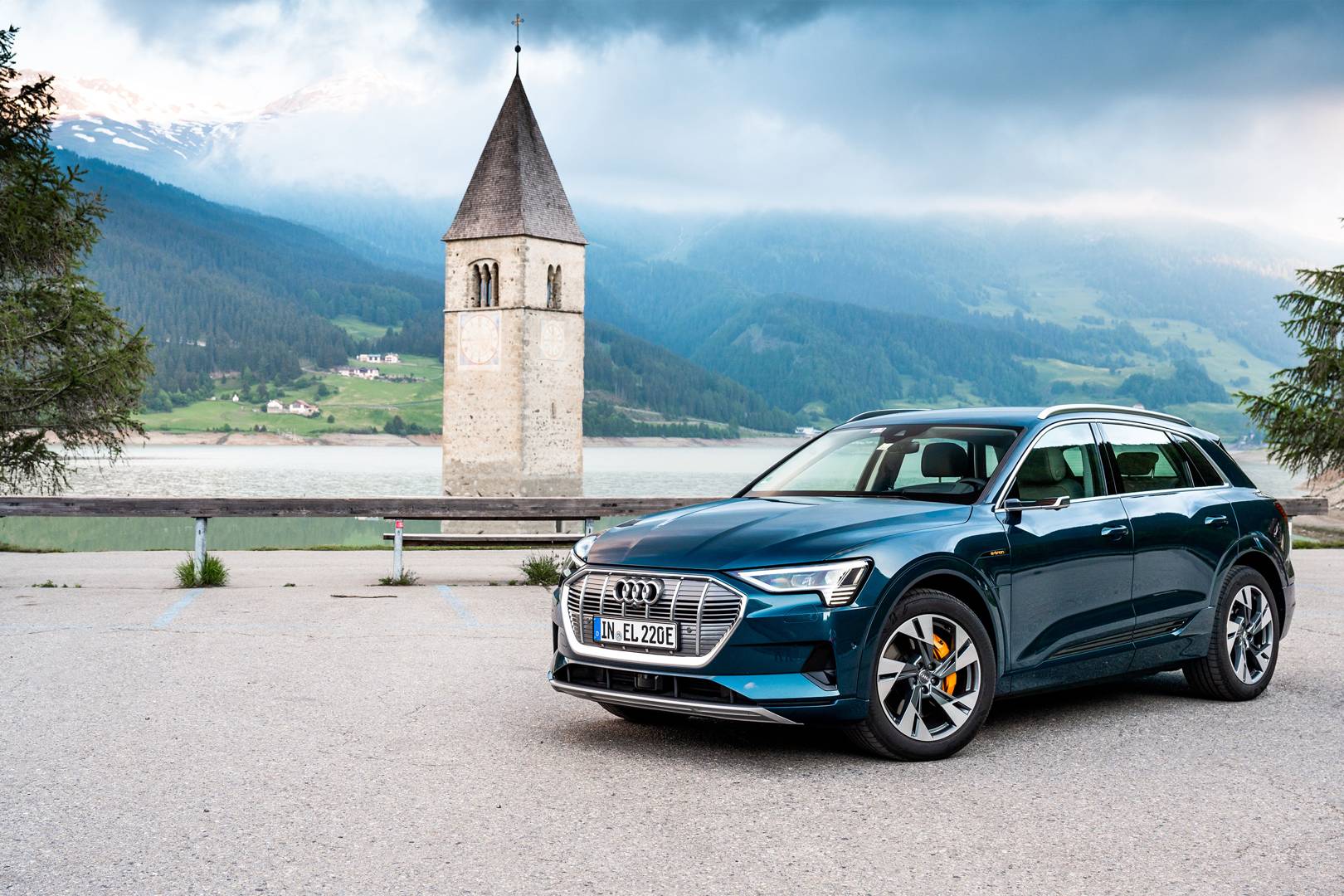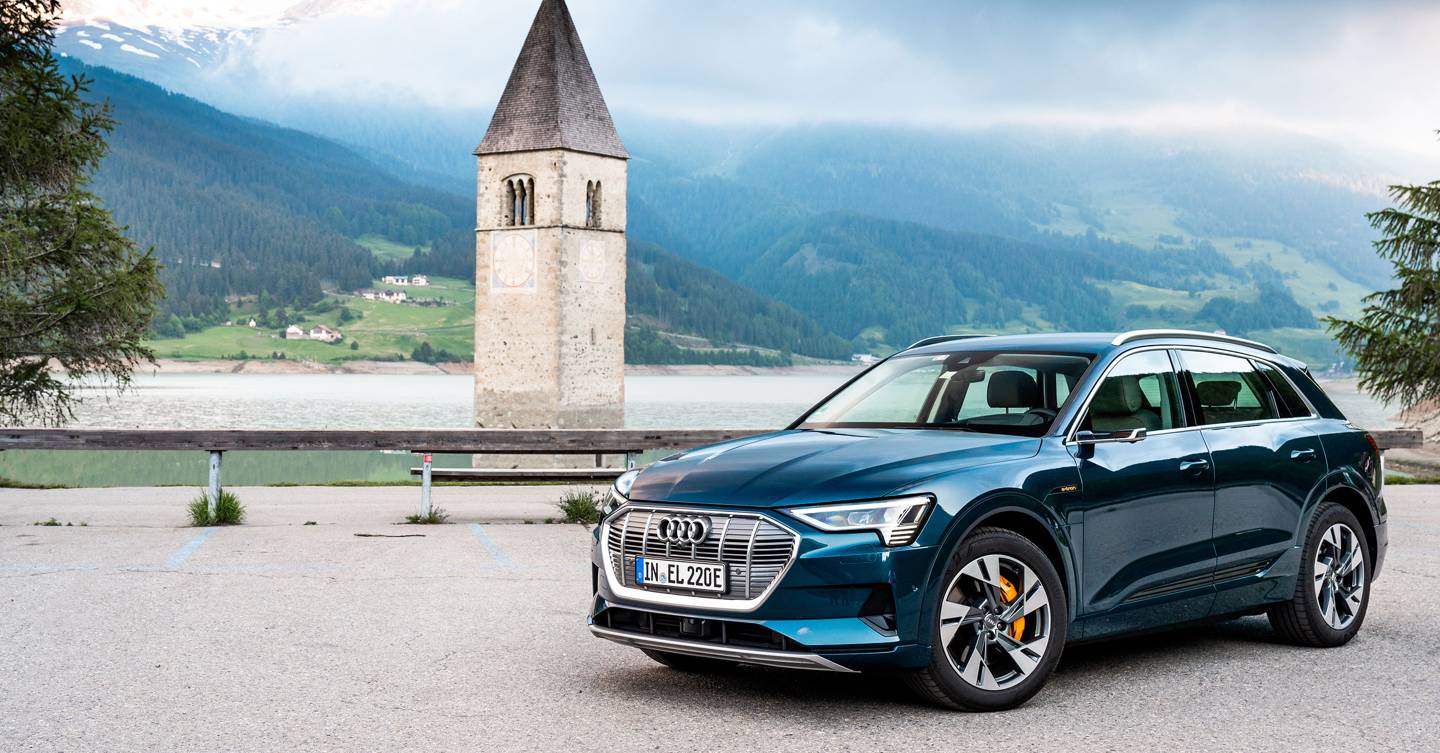

If you think electric cars are ‘a thing’ now, just wait till 2020. Next year will see the launch of more mainstream EVs and hybrids than ever before. Tesla’s grip on the segment is facing new challengers from manufacturers such as Jaguar, Mercedes-Benz, Kia, Hyundai and Audi. All have been building cars for far longer than Tesla, yet all find them vying for the same spot. Similarly, they all come up against the same criticism Tesla does: range and charging.
While all of the above can get you more than 200 miles on a charge, you’ll easily find someone saying that a double ton isn’t enough (this despite the fact that’ll easily cover an average week’s commuting for most), and that they take too long to charge.
To prove these people wrong, and to show how much confidence it has in its e-tron, Audi let me take one of its new EVs on a long-distance test, covering 1,000 miles across 10 European countries in 24 hours.
The plan was the start in Bled, Slovenia, and go through Austria, Italy, Switzerland, Lichtenstein, Belgium, Luxembourg, Germany and France, before stopping in The Netherlands to get a flight home. There were seven scheduled charge stops en route, though with the car’s official range of 248 miles, we should only really need five. Each charge would be administered by a 150kW fast-charger, capable of topping up the car’s battery in less than 50 minutes.
An average speed of 42mph would be needed to make it happen, which should be pretty manageable in just about anything with a motor and wheels. The e-tron will crack 0-62mph in 6.6 seconds if needed, and get up to 124mph on an autobahn.
Starting as a passenger (doing 1,000 miles in 24 hours on your own is a terrible idea and shouldn’t be attempted), I got to grips with the e-tron’s rear seats. From there you get a decent impression of one of its party pieces: the video wing mirrors.
Rather than big bits of glass attached to the outside of the car, two aerodynamically efficient stalks with cameras embedded in the end jut out of either side, feeding a live video to a screen in each door. The footage is lag free, and high-res enough to read a number plate at speed. They’re also bright, so handy for night-time cruising. Seeing as the e-tron is electric, you’d think that having two hi-res cameras on the go at all times would be a drain on power, but because of their shape they do more good for the range than harm.
An hour or so into the journey we stop for our first charge in Austria. The Ionity network of fast chargers dotted around the continent offer 150kW charging, meaning minimal stop-off times. In about 20 minutes we’d gone from 12 per cent charge to over 60 per cent. Given that we’d covered a fair amount of distance and the day is still young there is enough time for a cup of coffee and a leg stretch.
Older EVs may have taken hours to brim, but as charging tech and infrastructure gets faster and faster that should become a thing of the past. Porsche’s new Taycan is capable of 350kW charging, meaning a 400km charge will take just 15 minutes.
Battery tech is evolving fast. Similarly, how to pay for charges is getting easier. Audi’s own e-tron card, for example, covers you at more than 100,000 charge points from more than 400 suppliers in 19 European countries (with six more due before the end of the year), meaning you can stop, top up, and move on using only one card and receiving only one bill for your trouble. Previously you were limited to whichever service you were signed up for, and which card/app you had access to.
Taking the wheel for the next stint to Italy meant some quality time with the e-tron’s digital forward controls. There are three digital screens to feed information to your face. The first is an all-digital dash showing relevant information like speed, range, charge, drive time, etc.
Audi’s Virtual Cockpit can be tweaked to your preference, too, so you can have your nav right in front of you if you choose. The centre console has a touchscreen for infotainment and nav duties, and just below is a screen dedicated to air con and such. The nav display also shows a big blue pool around your current location, marking the out limit of your range so you know where you might need to stop. It’s all slick and lag free, offering a pleasing haptic buzz to let you know when you’ve pressed a button.
Those virtual wing mirrors take a little time to get used to. For the first hour or so you find yourself looking out to check a blind spot and making eye contact with a lens.
During my first run with the car it became pretty clear that Audi’s gone to lengths not to make an electric car, but a car that happens to be electric. Its power delivery is smooth, its ride supple and forgiving, but it doesn’t scream about its electric powertrain – it simply gets on with the business of being a car.
It’s not a problem-free car, though. And these problems come through no fault of its own, but through a lacking infrastructure. Our second stop in Italy wasn’t at a regular charger at all, but in something of a cheat in this test at a bank of Audi’s own power bricks (used e-tron batteries stacked up and charged ready to dispense stored electricity into our cars). Italy, it appears, is somewhat behind the rest of our route when it comes to charge points, and it begs the question if what would we have done had this Audi-supplied power not been to hand?
Car charged, we headed to the mountains. You wouldn’t expect a 2.6 tonne SUV to be a corner carver, but thanks to its instant power delivery and firmed up suspension in ‘dynamic’ mode it’s most entertaining.
Any worries about pushing its bulk up hill at speed needn’t be a bother, because every time you stamp on the brake pedal a lump of energy is fed back in to the battery. It’s not power neutral, you’re not going to maintain 100 per cent charge by driving up and down hills like a loon, but you get enough back not to worry about needing to call a tow.
As the 24 hours wore on, day turned to night and the roads became more traditional motorway fare. Hooning around mountains is fun, but it’s not conducive to covering vast distances over small time frames. The next couple of charges came and went quickly and without incident.
Five countries down, all was looking rosy. Heavy rain threatened to make one leg a bit of a pain, but nothing insurmountable. We were all set to have a successful trip in a great car and leave with a very boring story. But that wasn’t to be the case. The thing that would have made this a rousing success is if the considerable planning Audi had put in to the route had gone perfectly, but it didn’t.
Late in to the night, when we were feeling tired and sluggish, one dodgy charger en route held up the cars while it was fixed, eating in to our target time. Then France decided to throw a spanner in the works by closing a vital section of road. Rather than be able to breeze through a quick motorway stint, we were sent on a detour via tiny country lanes and a selection of small towns. Getting lost seemed inevitable.
Were we not running to a schedule, a delay for a broken charger wouldn’t have been a serious problem. A phone call and another cup of coffee would be on the cards. Or maybe a proper rest.
After more than 15 hours in the car everyone was beginning to sag a little. Words were slurred, thoughts muddled, moods dipped. The weak link, other than poor French infrastructure choices, was the organic component in the machine. Humans are weak, and take longer than 50 minutes to charge from 0-100 per cent. Our speed dropped as the night wore on and we doubted whether we’d make it.
Still, with various occupants napping in the back, we eventually made it to the last charge in Belgium. It was clear that we weren’t going to hit the Netherlands in time being the thick end of 200 miles short of our goal, but daylight and rough car sleep were preferable to an easily avoidable crash.
In the end the e-tron took us through the Dutch border 45 minutes after the 24-hour mark. A smidge over target, but still impressive.
This trip was an extreme example of what EVs can do, but it showed that breezy 1,000-mile long-haul road trips are in practise possible, but still require very careful planning. As the issues on my trip showed, unless you can magic up some industrial-grade power banks, and, for now at least, avoid Italy, there are still major hurdles to overcome before worry-free EV motoring across Europe is as simple as petrol-powered options. But, still, you can comfortably cover long distances without EV anxiety. Whether you should is another matter entirely.
Electric travel isn’t for everyone – recharge times still won’t suit all, and the lack of infrastructure means a last-moment 400-mile emergency trip to visit a sick relative won’t be feasible. But it can work for a growing majority of people. So long as they’re well-rested themselves.
More great stories from WIRED
💩 Japanese self-cleaning toilets are conquering the West
📱 The new Android 10 features that will transform your phone
📖 The best sci-fi books everyone should read
🍫 The foods you’ll really need to stockpile for no-deal Brexit
♻️ The truth behind the UK’s biggest recycling myths
read more at https://www.wired.co.uk/ by Alex Goy
Tech








